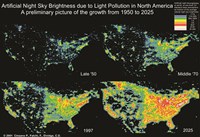- Lesson Plan (16)
- Field Trips (4)
- Distance Learning (3)
- Guest Speakers (1)
- Acadia National Park (4)
- New Orleans Jazz National Historical Park (2)
- Shenandoah National Park (2)
- Arches National Park (1)
- Bent's Old Fort National Historic Site (1)
- Brown v. Board of Education National Historical Park (1)
- Craters Of The Moon National Monument & Preserve (1)
- Cuyahoga Valley National Park (1)
- Florissant Fossil Beds National Monument (1)
- Show More ...
- Science (16)
- Social Studies (11)
- Literacy and Language Arts (7)
- Math (3)
- 6-8.RH.2 (4)
- 9-10.RH.1 (3)
- 9-10.RH.2 (3)
- 6-8.RH.1 (2)
- 6-8.RH.10 (2)
- 6-8.RH.4 (2)
- 9-10.RH.10 (2)
- 9-10.RH.3 (2)
- 9-10.RH.4 (2)
- Show More ...
Showing 24 results for UV light ...
Heat, Light, and Sound
- Type: Field Trips
- Grade Levels: Middle School: Sixth Grade through Eighth Grade
In these lessons, students investigate how energy moves through desert ecosystems in the form of heat, light, and sound. Students learn about insulators for heat and how sunscreen works to protect skin from UV light. They use sound to search for birds, and lenses to complete a scavenger hunt. The lesson concludes with a discussion about how too much heat, light, or sound can be harmful.
Lights, Camera, Action Lesson Plan
- Type: Lesson Plan
- Grade Levels: Upper Elementary: Third Grade through Fifth Grade
Who were the key figures in the Brown v. Board of Education court case? How did they contribute to desegregation?
Building A Better World (Arrow of Light Required Adventure)
- Type: Field Trips
- Grade Levels: Upper Elementary: Third Grade through Fifth Grade
Join one of our national park rangers as they facilitate a discussion about the rights and responsibilities that come with being a scout and citizen. They will introduce you to some famous and not so famous heroes that have made a difference in our community, country, and world. Be sure to ask the ranger about their work in building a better world. Fulfills requirements 2, 3, and 4.
Virtual: Grades 7-10: Waves in Acadia – Sound and Light
- Type: Distance Learning
- Grade Levels: Middle School: Sixth Grade through Eighth Grade
Draw sonograms. Measure infrared. Chart radio waves. Explore real world examples of light and sound waves in Acadia National Park with this interactive, virtual program. (1 hour)
National Park Legacy - Light Right at Night! Grades 7 - 8
- Type: Lesson Plan
- Grade Levels: Middle School: Sixth Grade through Eighth Grade
The night skies division of the National Park Service promotes 6 practices that everyone can adopt and make a difference in reducing light pollution: light only where needed, light only when needed, use less light, use warm colored light, use energy efficient lamps, shield and direct lights downward.
- Type: Lesson Plan
- Grade Levels: Middle School: Sixth Grade through Eighth Grade
The lesson could be used in U.S. history, social studies, and geography courses in units on nineteenth century and early twentieth century commerce or transportation, and to help students understand the role that maritime industries played in American history. The lesson could also be used to enhance studies related to the industrial revolution and women’s history.
Optical Illusions and Mirage on the Great Plains
- Type: Lesson Plan
- Grade Levels: Upper Elementary: Third Grade through Fifth Grade
Are your eyes playing tricks on you or is it the light? This lesson explores the properties of light and the environmental conditions which cause mirages. Students will examine some famous optical illusions before reading Josiah Gregg's experience with them when traveling across the Great Plains in the 1830s and 1840s.
Moon Phases With Cookies
Museum Scavenger Hunt (Self-Guided)
- Type: Field Trips
- Grade Levels: Upper Elementary: Third Grade through Fifth Grade
6th Grade | Virtual Shenandoah Watersheds
- Type: Distance Learning
- Grade Levels: Middle School: Sixth Grade through Eighth Grade
Shenandoah National Park lies at the headwaters for three of Virginia’s watersheds. Through virtual exploration and observation of a mountain stream, students will connect local water sources with larger watersheds and better understand the dynamics of stream life and the extensive impacts of water management and usage. 60 minutes
What is Algae?
FLAMBEAUX GLEAUX: THE NEW ORLEANS MARDI GRAS FLAMBEAUX STRIKE OF 1946
- Type: Lesson Plan
- Grade Levels: High School: Ninth Grade through Twelfth Grade
This lesson concerns a strike by FLAMBEAUX, men (generally African American) in New Orleans who carry large torches to light the parades. It concerns reasons a community might become militant and the role of solidarity in such struggles. It uses music created by the New Orleans Jazz National Historical Park that is found on the cd Remembering 300- Arrowhead Jazz Band.
Sharing Star Stories
- Type: Field Trips
- Grade Levels: Upper Elementary: Third Grade through Fifth Grade
Bring the night sky to your classroom with Sleeping Bear Dunes' mobile planetarium. This school visit explores how different cultures have connected with the night sky through constellations, and how light pollution threatens these connections. This program requires a large open room (like a gymnasium) that is at least 17 ft x 17 ft, and at least 12 ft high. The planetarium is accessible for students with physical disabilities.
Waste Not: 4th - 5th Grade
- Type: Lesson Plan
- Grade Levels: Lower Elementary: Pre-Kindergarten through Second Grade
White Sands National Monument and "Cook a Lizard" lesson plan cooperating purpose statement: The brilliant white dune field has resulted in extremely rapid and remarkable adaptations in endemic and native flora and fauna. Certain species of insects and rodents have quickly evolved a more whitish coloration.
6th-8th Grade | Virtual Shenandoah Salamander: Climate Change Casualty or Survivor?
- Type: Distance Learning
- Grade Levels: Middle School: Sixth Grade through Eighth Grade
The Shenandoah salamander is an endangered species found only on a few rocky slopes within Shenandoah National Park. Its survival is being threatened by changing climate and habitat competition from the more common red-backed salamander. Students will virtually explore and research to determine how climate change and habitat competition could be impacting the survival of the Shenandoah salamander. 60 minutes
Deep Time and You
Identifying Birds of Acadia
- Type: Lesson Plan
- Grade Levels: Lower Elementary: Pre-Kindergarten through Second Grade
















